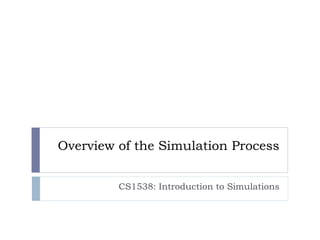This document provides an overview of simulation processes. It defines a computer simulation as a program that models the behavior of a physical system over time using program variables. A system consists of entities, attributes, activities, state variables, and events. Simulations can model discrete or continuous systems and be deterministic or stochastic. The steps in a simulation study are outlined. As an example, a simple simulation of a single server queue models customer arrivals and service times to analyze wait times and server idle time.














![Generating Random Events
Customer arrival time:
Suppose a new customer always arrives 6-10 minutes after the
previous customer arrives (discretized by minutes)
We’ll assume the random gap length is generated from a uniform
distribution
How do we implement this?
Assume we have rand() a function that returns a random
number between [0,1]
How about customer service (cooking) time with the
following distribution:
Cook time 3 min 4 min 5 min 7 min 8 min 9 min
Probability 0.1 0.2 0.3 0.25 0.1 0.05](https://image.slidesharecdn.com/bankentities-230517144333-f8a1e83c/85/Bank-entities-pdf-15-320.jpg)


